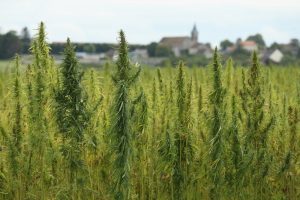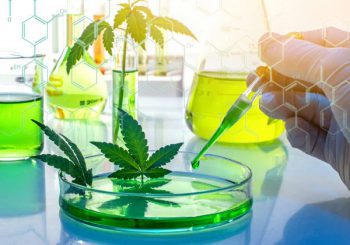Guest Writer for Wake Up World
For over 5,000 years, cannabis has been used for natural and holistic healing. Its use goes back to the foundation of Traditional Chinese Medicine and Chinese emperor Shen Nung – considered the father of Chinese Medicine – and the discovery that the healing benefits of the sacred plant once formed the backbone of medical practice.
A History of Cannabis
In ancient Egypt, cannabis was used to treat glaucoma, inflammation, and a host of other ailments. Cannabis pollen was even found on the mummy of Ramses II, who died in 1213 BC. Etymologists (those who study historic languages) believe that Hebrew writings from the book of Exodus describe cannabis extract as a primary ingredient in holy anointing oil.
Medical cannabis was also widely used in the Middle East. As far back as 1000 BC, it was used in India to treat a host of ailments, especially as an analgesic. The Venidad (an ancient Zoroastrian holy text) lists cannabis as the most important of nearly 10,000 healing plants. In Ayurveda, cannabis was considered a powerful healing agent and was recommended for treating the symptoms of depression.
Greek and Roman cultures used cannabis for ear pain, edema, inflammation, gout, malaria, memory loss, and sexual dysfunction. In 79 AD, Pliny the Elder – a naturalist and natural philosopher of the Early Roman Empire – wrote the Naturalis Historia in which he recommends cannabis for treating cramped joints, gout, and violent pain.
Cannabis was also used in the Middle Ages, when hemp was a commonly found healing agent. According to respected author and historian Martin Booth, “During the Middle Ages, hemp was central to any herbalist’s medicine cabinet. William Turner the Naturalist, considered the first English botanist, praises it in his New Herball, published in 1538.”
The Age of Persecution

In 1850, it was officially added to the U.S. Pharmacopeia as a proper medical treatment for a myriad of ailments. Neuralgia, tetanus, typhus, cholera, rabies, dysentery, alcoholism, opiate addiction, anthrax, leprosy, incontinence, gout, convulsive disorders, tonsillitis, insanity, excessive menstrual bleeding, uterine bleeding, and more were often treated with tinctures made from cannabis extracts. Cannabis was even featured in the prestigious medical journal The Lancet for its ability to help with opiate withdrawal, nausea, and vomiting. But things began to change at the start of the 1900s.
The Wiley Act of 1906 required cannabis to be labeled as “addictive and/or dangerous. From 1910 to 1927, during the height of the prohibition movement, cannabis was banned by Massachusetts, Maine, Wyoming, Indiana, New York, Utah, Vermont, Colorado, Nevada, Texas, Iowa, Oregon, Washington, Arkansas, Nebraska, and California.
However, the demand for medical cannabis was there. When cannabis import was disrupted by the First World War, America became self-sufficient, with pharmaceutical farms (including Eli Lilly) producing 60,000 pounds of cannabis in 1918. But global legislation was on the horizon that would label cannabis as an illegal substance.
In 1925, the League of Nations restricted the use of cannabis to medicinal and scientific purposes only. In 1928, cannabis was added to the Dangerous Drugs Act, prohibiting its use in the United Kingdom. In 1930, the Federal Bureau of Narcotics was formed. By 1937, Congress enacted the Marihuana Tax Act of 1937.
Promoted by Harry Anslinger, the commissioner of the Bureau, the new law did not technically make cannabis illegal… but it may as well have. Heavy taxes were imposed on doctors, pharmacists, and manufacturers. In order to apply for the tax stamp, these people would be required to admit to possession of the plant, therefore incriminating themselves. This made it essentially illegal for Americans to grow, buy, sell, or possess cannabis.
Disease Prevention
The Crucial Role of Homeostasis
The main job of the endocannabinoid system is to maintain balance (known as homeostasis) within the body as a whole in response to an ever-changing environment such as eating habits, level of stress, air quality, and much more. In addition to being a modulator, it’s secondary responsibilities are to protect and repair cells. According to the University of California, Los Angeles Cannabis Research Initiative, “Taxonomic investigation has revealed that the endocannabinoid system is incredibly old, having evolved over 500 million years ago. Moreover, it is present in all vertebrates – mammals, birds, reptiles, amphibians, fish, etc… all produce endocannabinoids.”
Dr. Raphael Mechoulam and his team, as well as other researchers, developed their understanding of the endocannabinoid system for over a decade. Scientists now know that endocannabinoids break down plant-based THC in large part through the activity of key enzymes that are part of the system. Some examples of important endocannabinoids include 2-Arachidonoyl Glycerol (2-AG) and Anandamide. Some examples of enzymes that help break down cannabinoids include acid amide hydrolase (FAAH) and monoacylglycerol lipase (MGL).
It was initially believed that the endocannabinoid system only existed in the nervous system and was mainly a support system for the brain. Later inquiry expanded this view and it is now known that the endocannabinoid system exists within the entire body and can have an effect on virtually all of the body’s systems.
Besides the nervous system and the brain, the state of a person’s endocannabinoid system can influence almost all of the body’s organ systems, including the immune system, the gut, the respiratory system, and the endocrine system. Cannabinoid receptors have been found in immune system cells, in the liver and pancreas, in skeletal muscle tissue and skin, in blood vessels and heart muscle, in the eyes, in the kidneys, in bone and fat, and in the GI tract.
Maintaining Wellness with Cannabis
Our bodies contain many complex systems, including the cardiovascular system, neurological system, and endocrine system. But the endocannabinoid system may be the most powerful of them all. When it comes to brain function, these chemicals and receptors have the ability to help prevent and heal many of the neurological issues that we encounter.
But sometimes things can go wrong. Sometimes our endocannabinoid system can suffer damage or fail to function properly. That’s where cannabinoids come in.
Think of endocannabinoids as unique keys that fit into millions of little locks throughout our bodies. Plant-based cannabinoids (exocannabinoids or phytocannabinoids) have the unique ability to mimic these keys and unlock doors that may otherwise have remained shut.
When it comes to disease, finding the right dosage and formulation for your specific and unique needs is super important. These various cannabinoids, terpenes, and flavonoids can work individually and (especially) in unison to help restore the body’s balance that leads to better overall wellness.
Disease Treatment
Since research has shown which effects each cannabinoid has on different ailments or diseases, growers of medical cannabis can breed cannabis to have more or less of each cannabinoid to treat the unique symptoms of specific ailments. Many farmers are now able to test their crops for cannabinoid content, which can help patients make more informed decisions. Additionally, knowing which cannabinoids have specific characteristics, such as high pain relief, growers can continue to refine their crops to help patients treat a variety of conditions.
Here are just a few of the conditions that can be helped by proper use of the cannabis:
Pain
A growing body of clinical research and a history of anecdotal evidence support the use of cannabis for the relief of some types of chronic pain, including neuropathic pain, and spasticity (ie, stiffness or tightness) associated with multiple sclerosis. In a recent comprehensive review of existing data on the health effects of cannabis and cannabinoids, the National Academies of Science concluded that adult patients with chronic pain who were treated with cannabis/cannabinoids were more likely to experience a clinically significant reduction in pain symptoms. They rated these effects as “modest.”
Studies also suggest some efficacy for cancer-related pain, migraines, and fibromyalgia, and other pain conditions. However, how different species, routes of administration, and doses differ in their effect is less clear, and more research is needed.
Cancer
There are many ways cannabis can help a person dealing with cancer. First, research continues to prove: cannabis kills cancer cells, shrinks tumors, and helps immune systems recalibrate. In most cases, when patients use cannabis in treatment, neuropathy fades, pain greatly reduces or diminishes completely.
Cannabis can also dramatically improve side effects of traditional treatment, most notably nausea and vomiting related to chemotherapy. Even the most conservative, skeptical physicians tend to agree and support the use of cannabis for that. It also directly affects and assists a patient’s natural healing processes. Among the reasons for this is supporting the patient in getting sleep, decreasing pain, stimulating appetite, decreasing stress and anxiety, and overall improving mood. All these things combined can give a patient one of the most important gifts – hope.
Brain Health
Your brain is arguably the most intricate and powerful organ in your body. It regulates everything from breathing and hunger to memory and motor skills. When we experience injury or dysfunction in the brain, these systems can begin to fail, resulting in a multitude of issues.
Emerging research over the past 20 years has shown that the endocannabinoid system (ECS) plays a major role in regulating neurological functions, protecting our brains, and prompting natural healing. And while there are many molecules within the cannabis plant that can help our natural mechanism to heal and combat symptoms of disease, the best way to maximize the medical benefits of cannabis is to utilize these compounds in conjunction with one another – the entourage effect.
While the ability of cannabis to treat these conditions is immense, the absolute best way to beat these diseases is prevention. In every condition we’ve covered, there is a common theme of ECS dysfunction. Cannabis helps by interacting with ECS receptors to restore balance and stimulate healing from within.
Autoimmune Disease
The immune system normally guards against germs like bacteria and viruses. When it senses these foreign invaders, it sends out an army of fighter cells to attack them. Usually, the immune system can tell the difference between foreign cells and cells that belong. In an autoimmune disease, the immune system mistakes part of your body, like your joints or skin, as foreign. It releases proteins called autoantibodies that attack healthy cells.
The endocannabinoid system is involved in immunoregulation and neuroprotection. Immune cells express both CB1 and CB2 receptors, secrete endocannabinoids, and have functional cannabinoid transport and breakdown mechanisms. There is significant biochemical evidence to suggest that biosynthesis (the creation of complex cells in our body), uptake, and degradation (the act of becoming less functional or breaking down of endocannabinoids) occurs in macrophages and leukocytes. This suggests that endocannabinoids can serve as local modulators of immune and inflammatory reactions. Think of someone standing at a light switch ready to turn it off and on at exactly the right time depending on how much light is in the room.
Studies have found that the CB2 receptors in the ECS can suppress immune response in the body. This has been shown by CBD’s ability to trigger (and not bind with) the receptor. When activated by CBD, the CB2 receptors reduce the production of inflammatory cytokine peptides (amino acid bonds) in the body and increase the anti-inflammatory cytokine peptides. As a result, any inflammation in the body is reduced or eliminated as the ECS uses CBD to restore homeostasis within the immune system.
In addition to working with the CB2 receptor to regulate the cytokine peptides, CBD also works to slow down T-cell production. A T-cell is a type of white blood cell that is created in the thymus, part of the lymphatic system of the body. It plays a central role in immune system response. In addition to slowing down T-cell production, CBD helps suppress immune system cell memory, which reduces the chances of further autoimmune attacks.
Getting Started
Whole Plant Medicine
 Whether you eat it, vaporize it, or ingest it as an oil, the cannabis you put into your body contains many chemicals that work together to potentially make you feel better. THC and CBD are the most known and most prevalent cannabinoids, but there are hundreds of other cannabinoids and compounds in the cannabis plant. The interaction of these chemicals is called “the entourage effect.”
Whether you eat it, vaporize it, or ingest it as an oil, the cannabis you put into your body contains many chemicals that work together to potentially make you feel better. THC and CBD are the most known and most prevalent cannabinoids, but there are hundreds of other cannabinoids and compounds in the cannabis plant. The interaction of these chemicals is called “the entourage effect.”
Using the whole plant or a whole plant extract is the only way to get the synergistic benefits that come along with the other “minor phytocannabinoids” in cannabis (which may also contribute to relevant activity). Cannabichromene (CBC) is the third most prevalent cannabinoid in cannabis, and has been shown to be anti-inflammatory, as well as analgesic. Cannabigerol (CBG) can interact with both CB1 and CB2 receptors. It also exhibits GABA uptake inhibition to a greater extent than THC or CBD, which could make it effective as a muscle relaxant for the spasticity seen in multiple sclerosis. CBG is also more effective at helping with skin irritation, pain relief, and other health concerns than THC.
Cannabinoid Ratios
The two main cannabinoids, CBD and THC, contain valuable and distinct medicinal properties and depending if you take them either together or individually, they have different effects on your body. Since CBD and THC are the cannabis plant’s two most prominent cannabinoids, most of the research as of today focuses on the ratio of each.
The understanding of cannabinoid ratios is still in the early stages. Each cannabinoid’s medical and therapeutic properties are distinct. Tetrahydrocannabinol (THC) and cannabidiol (CBD) differ in the way their molecules act on cannabinoid receptors in the brain. THC binds with the CB1 receptor and CBD binds with the CB2 receptor while also blocking CB1 receptors from binding with THC. This is why a good ratio of THC to CBD can help patients get the maximum health benefits while minimizing the potential intoxicating effects of THC.
Each CBD:THC ratio has a significant role in how cannabis acts in your body. In addition to considering the dosage you use (how much of each cannabinoid), It’s important to find the right ratio of CBD to THC. Finding the right ratio and dose is essential for finding the right protocol for each patient.
There’s no “perfect ratio” with CBD:THC ratios when it comes to how it will work for you specifically. Each is unique in how they’ll react to certain ratios and certain times of the day. One individual may prefer a 2:1 CBD:THC ratio, while another individual prefers a 0:5 ratio. Also, certain conditions might require different terpenoid and cannabinoid profiles along with managing medical cannabis around other drugs to avoid cross-reactions. For a lot of individuals, however, a CBD:THC 1:1 ratio is ideal.
Dosage
The difference between a proper dose or a bad dose could mean a safe experience versus discomfort and/or a dangerous one. A proper dose means safe medicine, a bad dose means discomfort that could lead to a dangerous situation. Fortunately, cannabis is remarkably safe; so, patients can find their perfect dose by ingesting it in small increments starting in ranges of 1- 2 mg or ml of whole plant applications. Our recommendation is to meet with a medical professional knowledgeable in cannabis dosing and your ailment.
Avram Goldstein, MD, Professor Emeritus of Pharmacology at Stanford University, stated the following during a medical cannabis conference on Feb. 20, 1997: “We know that there are no extreme immediate toxicity issues (with marijuana). It’s a very safe drug, and therefore it would be perfectly safe medically to let the patient determine their own dose by the smoking route.”
With that said, it’s safe to experiment when finding your perfect dose; Knowing your dose is of utmost importance, and therefore, should be taken seriously. When you make any purchase of medical cannabis (everything from flower to edibles) always look for the lab results of that product. Laboratories test the premium medical cannabis products to help guarantee your safety.
Importance of Working with A Professional
The most important thing you can do in your journey with cannabis is to work with a professional. Both your body and your specific set of ailments are unique, and there’s simply no such thing as a one-size-fits-all protocol.
Remember that it is essential to work with an experienced cannabis expert when developing your protocol. You must also work with your primary physician to avoid unnecessary interactions with your existing treatment and you must start slow while you learn how your body reacts to new formulations.
Whether you’re considering medical cannabis for the first time or have been using it for decades, the perfect protocol can change, and is almost always unique. Working with an experienced practitioner (and taking care to work with adjunct treatment instead of against it) will go a long way in ensuring that you have a positive experience and get the maximum benefits from this amazing plant.
Conclusion
Even though cannabis has been used as medicine for thousands of years, we are only at the very beginning of our journey to truly understanding and unlocking its full potential. Political and socio-economic prejudice have resulted in a world where the use of cannabis can still be a challenge for patients.
Though we have had tremendous insights into the value that this plant has in our own health and wellness, we have only just scratched the surface of our understanding as the research is still in its infancy. Doctors and scientists are required to jump through many hoops to conduct their research, and many are required to travel to distant countries to study cannabis.
That being said, the data we’ve collected so far is astounding: there may be no other plant in the world with such powerful and wide-reaching benefits to our health. From maintaining homeostasis to treating conditions like pain, epilepsy, or cancer, our greatest hope likely resides in a natural plant that’s been right under our noses this whole time.
Originally published at The Truth About Cancer and reproduced here with permission.
About the author:
 Ty Bollinger is a health freedom advocate, cancer researcher, former competitive bodybuilder and author. After losing several family members to cancer, he refused to accept the notion that chemotherapy, radiation, and surgery were the most effective treatments available for cancer patients. He began a quest to learn all he possibly could about alternative cancer treatments and the medical industry. What he uncovered was shocking. There is ample evidence to support the allegation that the “war on cancer” is largely a fraud and that multinational pharmaceutical companies are “running the show.” Ty has now made it his life mission to share the most remarkable discovery he made on his quest: the vast majority of all diseases, including cancer, can be easily prevented and even cured without drugs or surgery.
Ty Bollinger is a health freedom advocate, cancer researcher, former competitive bodybuilder and author. After losing several family members to cancer, he refused to accept the notion that chemotherapy, radiation, and surgery were the most effective treatments available for cancer patients. He began a quest to learn all he possibly could about alternative cancer treatments and the medical industry. What he uncovered was shocking. There is ample evidence to support the allegation that the “war on cancer” is largely a fraud and that multinational pharmaceutical companies are “running the show.” Ty has now made it his life mission to share the most remarkable discovery he made on his quest: the vast majority of all diseases, including cancer, can be easily prevented and even cured without drugs or surgery.
For more information, visit:

If you've ever found value in our articles, we'd greatly appreciate your support by purchasing Mindful Meditation Techniques for Kids - A Practical Guide for Adults to Empower Kids with the Gift of Inner Peace and Resilience for Life.
In the spirit of mindfulness, we encourage you to choose the paperback version. Delve into its pages away from screen glare and notifications, allowing yourself to fully immerse in the transformative practices within. The physical book enriches the learning process and serves as a tangible commitment to mindfulness, easily shared among family and friends.
Over the past few years, Wake Up World has faced significant online censorship, impacting our financial ability to stay online. Instead of soliciting donations, we're exploring win-win solutions with our readers to remain financially viable. Moving into book publishing, we hope to secure ongoing funds to continue our mission. With over 8,500 articles published in the past 13 years, we are committed to keeping our content free and accessible to everyone, without resorting to a paywall.







